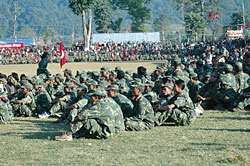 KIRAN PANDAY |
Contrary to the demand of other parties, the Maoists have not specified the number of ex-combatants to be integrated into the security forces in their working plan. The plan says that the committee will hear out each ex-combatant. The Maoists have been saying that it is necessary to first separate those who want to enter social and political life and those who want to take up a rehabilitation package. After this has been done, they say, the remaining ex-combatants should qualify for integration.
The Maoists claim that with such a model, they can separate the ex-combatants in two months and integrate the rest in the remaining one month. But until the dispute over whether security force integration numbers should be determined in the camps or through political consensus is resolved, their plan will not materialise. In this sense, the core of the debate on ex-combatant integration has not really changed.
The Maoists argue that integration should be based on the standards outlined in the Comprehensive Peace Accord, as opposed to existing legal provisions, and that personal admission cannot be a model for integration. But this is unacceptable to the government, as it puts the Maoist army and the Nepal Army on the same footing. The Maoists have also proposed an alternative model of organising ex-combatants to form a new special security department. But since nothing of this sort was mentioned in the peace accord, it is highly unlikely that the parties will agree to it.
The Maoists' proposal may not be acceptable to the other parties but they can table an amendment proposal or a different proposal based on it. Because until the issue of ex-combatant integration has been settled, constitution building and the peace process will not move forward. The formation of a consensus government, which is the most pressing need of the hour, will also not go materialise until the ex-combatants are successfully integrated.


